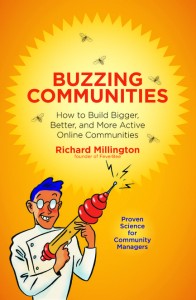 I’m a huge fan of London-based community management authority Richard Millington’s blog. Rich’s posts are always thoughtful, concise, and most importantly, useful. So when Rich contacted me last month and asked if he could send me a copy of his new book to review for this blog, I jumped at the chance.
I’m a huge fan of London-based community management authority Richard Millington’s blog. Rich’s posts are always thoughtful, concise, and most importantly, useful. So when Rich contacted me last month and asked if he could send me a copy of his new book to review for this blog, I jumped at the chance.
Buzzing Communities is an overdue kick in the ass for community managers. As Rich writes, “The time has come for community management to become a professional discipline.” Too many of us rely on instinct rather than data. Too many of us react to our members rather than focusing on activities that yield measurable results. Too many of us fail to demonstrate the value of communities with cold, hard facts. Read this book and you’ll learn to do all of that and more.
Buzzing Communities is essentially a how-to manual for community managers. It’s thorough and includes several scholarly references, but don’t let that scare you off. This book is well organized, readable, and full of actionable information.
Buzzing Communities aims to help community managers focus their efforts on activities that create real value. Rich groups these high value tasks into eight categories, and he’s written a chapter on each: Strategy, Growth, Content, Moderation, Events & Activities, Relationships & Influence, Business Integration, and User Experience. In each chapter, Rich explains why these tasks are important, provides tips on how to succeed, and gives specifics on how to measure your success. For example, in the Events & Activities chapter, Rich discusses how events build community spirit and activity, provides some great ideas for both online and offline events, then describes how you can measure the success of your events.
As I read through Buzzing Communities, I found myself bookmarking several pages and making lots of notes in the margins. I nodded in agreement with most of the book, and took note of several great ideas that hadn’t occurred to me. The only place where I found myself disagreeing with Rich was in his chapter on moderation, where he suggested a few ways to keep order in the community that I can’t support. But those differences of opinion won’t keep me from heartily recommending this book.
That said, this book isn’t for everyone. If you (or your company) hasn’t already established that a thriving online community will generate revenue or save money, this book won’t help you. Also, given the growing misuse of the term “community manager,” I should note that this book is not for those who manage an organization’s social media presence.
Rich describes online communities this way: “An online community is a group of people who have developed relationships around a strong common interest.” If your job is to manage a community like this, you really ought to read this book.